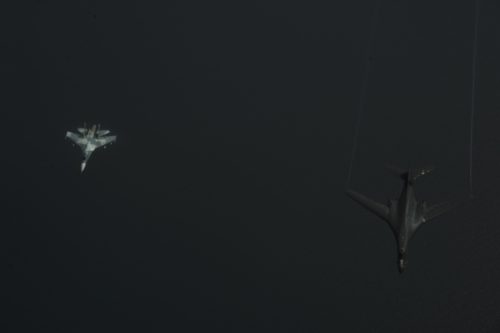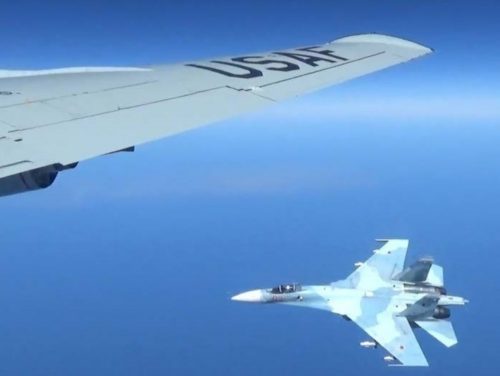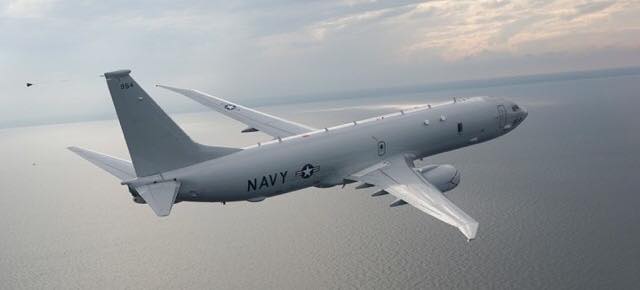Russian jets buzzing US planes is sign of Russia’s inferiority complex
On Tuesday, a Russian fighter engaged in yet another “unprofessional” intercept of a U.S. military plane in international airspace. The Su-27 Flanker reportedly flew within 20 feet of a Navy P-8 Poseidon surveillance/patrol aircraft over the Baltic Sea.
The Department of Defense has given little information on the nine-minute encounter other than stating that interactions with foreign militaries are routine and that this event was considered “safe” but “unprofessional.” Military aircraft are free to operate in international airspace and will likely be met when operating near the border of another nation. But with a string of recent provocative and dangerous antics in the air, Russia looks like a nation that has developed an inferiority complex.

On January 29, 2018 another Su-27 harassed a U.S. Navy EP-3 Orion reconnaissance plane in a similar event over the Black Sea. The U.S. 6th Fleet, which covers the European and African area, issued a statement declaring that the confrontation lasted for two hours and 40 minutes, with the Russian jet closing to “within five feet” from the American plane.
The fighter flew “directly through the EP-3’s flight path, causing the EP-3 to fly through the Su-27’s jet wash,” prompting the State Department to issue a press release voicing their “highest level of concern.”
Spokesperson Heather Nauert called on Russia to “cease these unsafe actions that increase the risk of miscalculation, danger to aircrew on both sides, and midair collisions.”
Why does Russia do it? It’s a dominance thing.
For one, American pilots are, without a doubt, the best military aviators in the world. Russian prestige is at stake, and her pilots want to show the world that they are hot stuff. Provided the Russians can avoid accidentally smashing their plane into the American jet, they can harass (unarmed) American pilots with relative impunity. Any negative press about unsafe, unprofessional flying can be framed by Vladimir Putin’s defense officials as whimpering from an effeminate U.S. military.
Two, there’s history: during the beginning of the Cold War, American spy planes flew over Soviet airspace knowing there wasn’t anything the Kremlin could do about it. Soviet Premier Nikita Khrushchev had to sit on his hands while American U-2s crisscrossed the skies, as their planes and missiles couldn’t reach the altitudes at which the high flying U-2 operated.
That is, until a surface-to-air missile shot down CIA pilot Francis Gary Powers on May 1, 1960, 58 years ago this week.
Three, its territorial. Apart from Alaska, thousands of miles of oceans separate the United States from Russia, while the Russians are flanked by their former Soviet republics, some of which are now partnered with the United States and NATO. We can fly reconnaissance missions from bases in Europe, Japan, or from our fleet of carriers (Russia only has one). While we occasionally hear about an antiquated Bear bomber approaching Alaska before turning back to the Motherland, Russia just does not have the ability to fly intelligence-gathering missions off our coasts like we do theirs.
A Recent History of Dangerous Russian Intercepts
Going back to Dec. 13, 2017, U.S. Air Force F-22 Raptor fighters had to intercept Russian Su-25 Frogfoot ground attack jets and fire warning flares when the Su-25s entered a section of Syrian airspace prohibited to Russian aircraft. Reportedly, the Russian pilots harassed the Americans for 40 minutes, and one of the Raptors had to evasively maneuver to avoid a mid-air collision with a Frogfoot.
The Syrian confrontation occurred after repeated violations of airspace by Russian warplanes that the Russians themselves previously agreed not to operate in.
In another Black Sea incident, a Russian Su-30 fighter crossed the flight path of another U.S. Navy P-8 on Nov. 25, 2017. The maneuver caused the American jet to fly through the fighter’s jetwash, subjecting the Poseidon’s crew to “violent turbulence” and a 15-degree roll.
Another Su-27 made a dangerous intercept of a P-8 over the Black Sea on Sept. 7, 2017, flying within 10 feet of the American sub hunter.

In May of last year, a pair of Su-24 Fencer bombers buzzed the guided-missile destroyer USS Porter (DDG-78) in the Black Sea, and another pair of Fencers buzzed the guided-missile destroyer USS Donald Cook (DDG-75) operating in the Baltic Sea in April 2014. The Defense Department called both incidents “unsafe and unprofessional.”
On April 14, 2016, yet another dangerous encounter occurred over the Baltic Sea when another Su-27 approached an Air Force RC-135U Combat Sent electronic-intelligence aircraft at a high rate of speed, closing to a distance of 50 feet, then performed a barrel roll over the top of the American plane.
On April 24, 2014, a Su-27 intercepted another Combat Sent aircraft over the Sea of Okhotsk, crossing within 100 feet of the aircraft’s nose, in what was deemed at the time the worst such incident since the end of the Cold War.

Sea was intercepted by a Russian SU-27 Flanker June 19, 2017. Due to the high rate of closure speed and poor control of the aircraft during the intercept, this
interaction was determined to be unsafe. (U.S. Air Force photo by Master Sgt. Charles Larkin Sr.)
These dangerous Russian intercepts violate the 1972 Agreement for the Prevention of Incidents On and Over the High Seas, which states that aircraft “shall use the greatest caution and prudence in approaching aircraft and ships of the other Party operating on and over the high seas.”
States have every right to safely intercept planes and ships approaching their territory, but since the treaty does not spell out what constitutes safe and professional conduct, Russia can deny any wrongdoing and get away with their behavior—even when they are caught red-handed on video.
Russia’s intercepts of legal, non-threatening U.S. military flights in international airspace are becoming increasingly provocative, dangerous, and could potentially become a flashpoint between the United States and Russia. These are the actions of a nation in decline, desperately attempting to appear tougher than they actually are. It’s sad to see the once-dreaded Russian Bear appearing to have withered away to a chihuahua nipping at the heels of unarmed American reconnaissance planes.
[Originally published at OpsLens.com]
